by Rebecca Mitchell-Guthrie
 Rosemary began its spiky life on the cliffs and in the crevices of the Mediterranean coast, so the sea figures prominently in its lore.
Rosemary began its spiky life on the cliffs and in the crevices of the Mediterranean coast, so the sea figures prominently in its lore.
In Latin rosemary means “dew of the sea.” Mist from the sea helped it thrive in the rocky coastal landscape of the Mediterranean.

Greek Aphrodite as Roman Venus
In Greek mythology, Aphrodite was born from the sea. She rose up from the foaming waves adorned with garlands of rosemary. Aphrodite is the Greek goddess of love, beauty, and pleasure. Rosemary has also been symbolic for remembrance and loyalty, and it has also been used in weddings and funerals in ages past.
Our human history with rosemary has many branches. Shakespeare mentions it in Hamlet and in Romeo and Juliet, and rosemary was used for protection during the Black Plague in a concoction called Thieves Oil.
There are three varieties of rosemary that you may see in aromatherapy:
Rosmarinus officinalis ct. cineole
Rosmarinus officinalis ct. verbenone
Rosmarinus officinalis ct. camphor
In the names there above, “ct.” stands for “chemotype,” which simply means variety. Chemotypes, or varieties, in rosemary occur because of conditions like inherent plant variety, light, soil, location, and temperature of where it is grown.
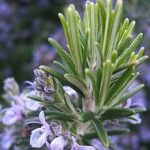 Mostly you will see the first two oils (the variety of cineole or verbenone) available for purchase. The third variety is high in camphor, not used quite as often, and is not as aromatically inviting as the first two. Please avoid the camphor variety of rosemary if you have epilepsy, and all rosemary essential oil if you are pregnant or have asthma.
Mostly you will see the first two oils (the variety of cineole or verbenone) available for purchase. The third variety is high in camphor, not used quite as often, and is not as aromatically inviting as the first two. Please avoid the camphor variety of rosemary if you have epilepsy, and all rosemary essential oil if you are pregnant or have asthma.
Rosmarinus officinalis ct. cineole I used this oil to wake up on a sleepy summer afternoon while I was working on a writing project after lunch. I found it to be a very effective stimulant.
Rosmarinus officinalis ct. verbenone
Rosmarinus officinalis ct. camphor This rosemary can be used similarly to the two other varieties above. It has a stronger camphor smell and should not be used with children.
Source: Harding, J. (2010). The Essential Oils Handbook, New York, NY: Sterling Publishing Co., Inc. pp. 112-113; Schnaubelt, K., PhD (2011). The Healing Intelligence of Essential Oils. Rochester, VT: Healing Arts Press. pp.68-70; Haas, M. (2004). Quick Reference Guide for 114 Important Essential Oils, San Rafael, CA: Terra Linda Scent and Image. pp. 94,95,96.
Image: photo of sea by Fourat / CC-BY-SA-3.0; photo of rosemary by Thor CC-BY-2.0
Articles copyright of Rebecca Mitchell-Guthrie and not to be reprinted without permission.
The information presented on this site is not intended to diagnose health problems or to take the place of professional medical care. The information contained therein is neither intended to dictate what constitutes reasonable, appropriate, or best care for any given health issue, nor is it intended to be used as a substitute for the independent judgment of a physician for any given health issue. All content, including text, graphics, images and information, contained on or available through my web site is for general information purposes only.
by Rebecca Mitchell-Guthrie
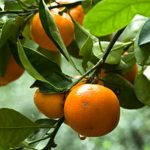
Citrus aurantium
The bitter orange tree gives us three fabulous essential oils, all from one plant:
- Neroli essential oil
- Petitgrain essential oil
- and Bitter Orange essential oil
The bitter orange tree originated in Vietnam, but like all popular plants it is cultivated in many global locations now. It is known to be a very hardy tree, able to resist disease. From marmalade to liqueur to essential oils, its popularity is in no danger of fading.
Neroli
Guess what? The secret ingredient in a very popular soft drink… is Neroli essential oil. Yes, that is right. This unbelievably beautiful oil is one of those strange flavors that you find in Coke. I think that these days the Neroli in it is synthetically produced for economic purposes, but originally it was the true Neroli essential oil.
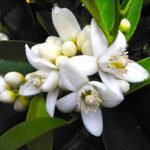
Orange Blossoms
Neroli essential oil comes from the flowers of the bitter orange tree. This oil is expensive. Why? Because it takes 100 pounds of flowers to distill just one pound of essential oil. These flowers are hand-picked. They are distilled with water due to the fact that steam distillation would be too harsh for this delicate flower. The aroma is sweet and spicy. It was made popular as a perfume in the 17th century by the princess of Nerola, Italy, hence the name. Many perfumes use this oil as an essential ingredient because it is nontoxic, nonirritant, and nonphototoxic.
Mostly you will find this essential oil for sale only if it is diluted with an inexpensive carrier oil like jojoba. That allows you to get the benefits of the aroma of the oil without the steep price tag.
Petitgrain
To make petitgrain essential oil, the leaves and twigs of the bitter orange tree are steam distilled. The countries producing most of Petitgrain essential oils are France and North Africa.
Bitter orange
To make Bitter Orange essential oil, the fruit peel is cold pressed. Egypt, the United States, and Brazil are the largest producers of this fabulous oil. If you don’t like the sweetness of Orange essential oil, try Bitter Orange instead. Blend this essential oil with ginger, lavender, myrrh, or vetiver for an exotic and lovely mix.
Sources: Harding, J. (2010). The Essential Oils Handbook, New York, NY: Sterling Publishing Co., Inc. pp. 130-131, 256-257; Schnaubelt, K., PhD (2011). The Healing Intelligence of Essential Oils. Rochester, VT: Healing Arts Press. pp. 114-115; Haas, M (2004). Quick Reference Guide for 114 Important Essential Oils, San Rafael, CA: Terra Linda Scent and Image. pp. 80, 88.
Articles copyright of Rebecca Mitchell-Guthrie and not to be reprinted without permission.
The information presented on this site is not intended to diagnose health problems or to take the place of professional medical care. The information contained therein is neither intended to dictate what constitutes reasonable, appropriate, or best care for any given health issue, nor is it intended to be used as a substitute for the independent judgment of a physician for any given health issue. All content, including text, graphics, images and information, contained on or available through my web site is for general information purposes only.
Image credit: Orange Tree Branch by Liz West Muffet / CC-BY-2.0
Image credit: photo of Neroli by Starzyia / CC-BY-ND-2.0
by Rebecca Mitchell-Guthrie
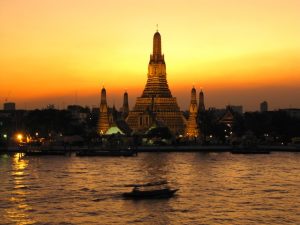
Bangkok. Copyright Rebecca Mitchell-Guthrie.
One unique experience with an essential oil occurred during a trip to Bangkok, Thailand. Thai culture values massage, especially foot massage. Everywhere in Bangkok you can find small shops or stalls that specialize in these, usually for about $7. The foot massage I had was given using a carrier oil with Lemongrass essential oil (Cymbopogon citratus). The lemongrass essential oil foot massage helped the horrible headache and nausea I had from eating a bad meal. What relief.
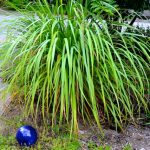
Lemongrass
Lemongrass essential oil has chemical compounds that are beneficial in a foot massage. Some of these compounds are identified as aldehydes, which have been shown to reduce inflammation, are calming to the central nervous system, and they are antiviral. Since aldehydes can be a possible dermal irritant, Lemongrass essential oil is safe for the skin when it is diluted in a carrier oil.
In addition, Lemongrass essential oil is high in chemical compounds called monoterpenes. Monoterpenes are antiseptic and mild expectorants.
Try this for a relaxing and anti-fungal foot massage blend:
- 1 tablespoon Jojoba or Sweet Almond oil
- 1 drop Lemongrass essential oil
- 1 drop Lavender essential oil
- 1 drop Tea Tree essential oil
Source: Harding, J. (2010). The Essential Oils Handbook, New York, NY: Sterling Publishing Co., Inc. pp. 104-105.
Images: photos copyright Rebecca Mitchell-Guthrie
Articles copyright of Rebecca Mitchell-Guthrie and not to be reprinted without permission.
The information presented on this site is not intended to diagnose health problems or to take the place of professional medical care. The information contained therein is neither intended to dictate what constitutes reasonable, appropriate, or best care for any given health issue, nor is it intended to be used as a substitute for the independent judgment of a physician for any given health issue. All content, including text, graphics, images and information, contained on or available through my web site is for general information purposes only.
by Rebecca Mitchell-Guthrie
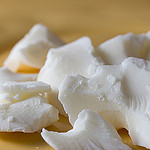 Cacao for skin care is simply amazing. It is inexpensive, stays fresh for a very long time, is safe to use on the skin, has been used in medicinal folk remedies in ages past, and protects and lubricates the skin. And that is not all! One of my very favorite things about it is that a piece is easily transported with you during travel.
Cacao for skin care is simply amazing. It is inexpensive, stays fresh for a very long time, is safe to use on the skin, has been used in medicinal folk remedies in ages past, and protects and lubricates the skin. And that is not all! One of my very favorite things about it is that a piece is easily transported with you during travel.
Cacao (the raw form of the seed of Theobroma cacao, which is basically the cacao bean) is a skin moisturizer and contains oleic acid. It melts at body temperature, and the natural fats are easily absorbed by the skin for conditions. Cacao beans are rich in a number of essential minerals, including magnesium, sulfur, calcium, iron, zinc, copper, potassium, and manganese. They contain the fatty acids of oleic: 29-35%, palmitic: 20-30%, and linoleic: 1-3%.
I use it for dry skin. It absorbs and seems to work well for me.
Articles copyright of Rebecca Mitchell-Guthrie and not to be reprinted without permission.
The information presented on this site is not intended to diagnose health problems or to take the place of professional medical care. The information contained therein is neither intended to dictate what constitutes reasonable, appropriate, or best care for any given health issue, nor is it intended to be used as a substitute for the independent judgment of a physician for any given health issue. All content, including text, graphics, images and information, contained on or available through my web site is for general information purposes only.
Image credit: Cocoa Butter by Veganbaking.net / CC-BY-SA 2.0
by Rebecca Mitchell-Guthrie
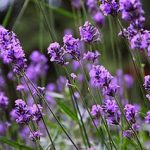
Lavender
Lavandula angustifolia is the lavender with which people are most familiar. However, there are over 200 varieties of lavender in the world. Most of these are not used in aromatherapy though.
These are three lavenders you might find in an aromatherapy office:
- Lavender
- Spike Lavender
- Lavandin
To make it even more confusing, within these main varieties there are several chemotypes. What is a chemotype? Think of it as chemistry type. Climate, location, light, soil, and temperature all affect the chemistry of any plant on our planet. This matters because one chemotype of lavender grown in Corsica may have more of one compound than another type grown in California. Knowing the origin gives you information about particular uses for these chemotypes. There are varieties of chemotypes of many different herbs, but the most familiar ones are varieties of eucalyptus, rosemary, and chamomile. For now, we will only discuss the three lavenders and their personalities, and why one more than another might be useful to you on your life journey.
Lavandula angustifolia, “Lavender” is native to the Mediterranean, although lavender is grown in many parts of the world today. Distilling the leaves, stems and flowers give lavender its signature camphor and sweetness in aroma.
Lavandula latifolia syn. spika, “Spike Lavender” is one beautiful and hardy Lavender, with long greyish-green leaves and tall spikes with flowers. You can easily find this variety in the Mediterranean, Spain, Italy, and France, as well as other places around the globe. Spike Lavender has a sharper aroma than regular lavender, rich with woody notes.
Lavandula x intermedia, “Lavandin” is a hybrid between true Lavender and Spike Lavender. How clever! One of my personal favorite oils, it is one smart lavender, with traits and capabilities of both lavenders combined. This plant is a tough variety and does well in scrubby areas and hot climates. The flowers on Lavandin can be white or purple, although most are purple. It produces a very high yield, due its tall stature and large flowers. The aroma is bright, strong, sweet and stimulating.
Sources: Harding, J. (2010). The Essential Oils Handbook, New York, NY: Sterling Publishing Co., Inc. pp. 106-107, 134-135; Schnaubelt, K., PhD (2011). The Healing Intelligence of Essential Oils. Rochester, VT: Healing Arts Press. pp.125,168; Haas, M. (2004). Quick Reference Guide for 114 Important Essential Oils, San Rafael, CA: Terra Linda Scent and Image. pp. 61, 62
Articles copyright of Rebecca Mitchell-Guthrie and not to be reprinted without permission.
The information presented on this site is not intended to diagnose health problems or to take the place of professional medical care. The information contained therein is neither intended to dictate what constitutes reasonable, appropriate, or best care for any given health issue, nor is it intended to be used as a substitute for the independent judgment of a physician for any given health issue. All content, including text, graphics, images and information, contained on or available through my web site is for general information purposes only.
Image: photo by Riley Huntley / CC-BY-SA 3.0
 Rosemary began its spiky life on the cliffs and in the crevices of the Mediterranean coast, so the sea figures prominently in its lore.
Rosemary began its spiky life on the cliffs and in the crevices of the Mediterranean coast, so the sea figures prominently in its lore.
 Mostly you will see the first two oils (the variety of cineole or verbenone) available for purchase. The third variety is high in camphor, not used quite as often, and is not as aromatically inviting as the first two. Please avoid the camphor variety of rosemary if you have epilepsy, and all rosemary essential oil if you are pregnant or have asthma.
Mostly you will see the first two oils (the variety of cineole or verbenone) available for purchase. The third variety is high in camphor, not used quite as often, and is not as aromatically inviting as the first two. Please avoid the camphor variety of rosemary if you have epilepsy, and all rosemary essential oil if you are pregnant or have asthma.





